SigC54xx MP3 Real-Time System
Signalogic is developing a bit-exact, real-time MP3 implementation for Texas Instruments C54xx DSP processors,
based on the Fraunhofer MP3 "standard" .wav and .mp3 files published
on the FhG
website. C54xx source has been created and modified to provide multichannel real-time operation, layer 2 and layer 3
selectable operation, host setup properties to control algorithm parameters, including analog I/O (voice) and digital I/O
interrupt-tolerant execution and resolution of C54xx pipeline issues.
Bit rates as low as 128 kbps make the MP3 audio compression
algorithm suitable for a wide range of telecom
applications, including Intenet infrastructure.
Signalogic has demonstrated real-time MP3 on SigC54xx CONAN SODIMM
and SIMM multiprocessor modules, which are small form-factor multi-DSP modules
used by telecom clients. Supporting modules include the SigSD4
Audio Module, also in SODIMM form-factor, which provides 4-channel 16-bit
sigma-delta analog I/O.
The SigC54xx MP3 System is fully supported by the
SigC54xx Development System,
and DirectDSP software, which provides direct access, analysis, monitoring,
and real-time debug capabilities from C/C++ (MSVC and Borland), MATLAB,
Visual Basic, and LabVIEW host environments.
A production MP3 system is being implemented based on the
SigC54xx-PC/104 board, which provides small
form-factor, high-density multichannel MP3 performance, suitable for
stand-alone operation in rugged environments.
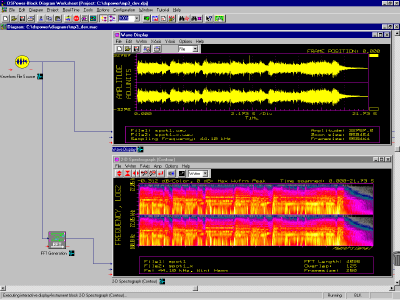
Frequency domain (2-D spectrograph) and time domain
(waveform display/edit) graphs of pre-MP3 audio data (trace 1),
and MP3-processed data (trace 2).
Click here to listen to the
raw waveform sample
and MP3-processed audio waveform sample
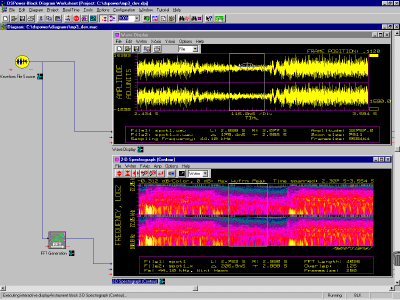
same data as above, with detail zoom. Click here to listen to the
raw waveform sample
and MP3-processed
waveform sample
Overview
The SigC54xx MP3 System is a low-cost, scalable, modular signal processing
approach based on fixed-point off-the-shelf Texas Instruments C54xx DSP
devices. Features of the SigC54x MP3 System include:
Multichannel real-time performance. The SigC54xx MP3 System is
capable of fully processing and MP3-encoding up to twelve (12) half-duplex,
and six (6) full-duplex channels at 8 kHz sampling rate (16-bit data).
Scalability. The SigC54xx MP3 System provides scalable MP3
performance and channel capacity by taking advantage of small, multiprocessor
72-pin SODIMM modules to provide flexible configuration of number of processors,
type and performance of processor, and amount of dedicated SRAM per processor.
This approach makes different customer configurations and product and
field upgrades straightforward.
Flexible audio interface. A low-cost, simple,
MP3 Development SystemFeature Summary
Small form-factor for MP3 production systems. The SigC54xx-PC/104 board is implemented in PC/104 form-factor, which allows OEM manufacturers to embed multichannel MP3 capability in a volume approximately 3.5" x 3.75" x 1.0"
The MP3 Development System offers real-time MP3 performance in a PC-based,
desktop form-factor suitable for proof-of-concept and application-specific
development requirements.
The MP3 Development System is based on the
The default-configuration MP3 Development System:
contains two (2) COTS SigC549-SODIMM modules,
in 72-pin SODIMM format,
each with (3) 100 MHz C549 processors. On these modules, each processor
has its own dedicated 128k x 16 SRAM, organized as 32k x 16 Data
SRAM and 96k x 16 Program SRAM
contains one (1) 4-channel, 16-bit sigma-delta analog I/O
SigSD4 Audio Module, also in 72-pin SODIMM format.
Two (2) of Cirrus Logic CS4218 audio codec devices are used on the
Audio Module; each codec is 2-channel and contains both
A/D and D/A converters. The sigma-delta converters provide
software-programmable sampling rates from 4 kHz to 48 kHz (signal bandwidth
from 2 kHz to 24 kHz), built-in anti-alias and reconstruction filters,
highly linear phase response, and software-programmable input gain from
0 to +22.5 dB and output attenuation control from 0 to -22.5 dB. (Note:
the required bandwidth to be supported by real-time MP3 processing is
4 kHz).
is connected to Win9x host PC using high-speed host-interface card
is initialized, configured, and controlled by
DirectDSP software, with direct
interface from C/C++ (MSVC and Borland), MATLAB, Visual Basic, and LabVIEW
In addition to general development features and popular host environment
support (MATLAB, C/C++, etc.) provided by the
SigC54xx Development System, the
MP3 Development System includes a user-interface "control panel" which
provides common MP3 development functions, including:
input/output to serial port card in the PC
input/output to TIM, WAV, or ASCII text waveform files
raw and processed data display, both in time domain and in
frquency domain, including 3-D spectrogram and 2-D spectrograph
real-time measurement capability (e.g. frames per sec)
mode control; e.g. file-based simulation, real-time audio
input, etc.
real-time control over MP3 DSP code (e.g. analysis mode, synthesis
mode, combined mode)
The MP3 Production System is composed of a multi-module site board in PC/104
form-factor. This board, called the SigC54xx-PC/104, contains four (4) SODIMM
module sites, host PC interface, digital I/O (RS-232 and RS-423) interface
and connectors, JTAG debug headers, standard PC/104 bus connectors, and 100-pin
"Global Bus" connector for peripheral expansion.
The SigC54x-PC/104 board can accept SigC54xx-SODIMM
multiprocessor modules, and SigSD4-SODIMM Audio
Modules. A standard SigC549-SODIMM module contains
three (3) 100 MHz C549 processors and three (3) sets of 128k x 16 SRAM devices.
A standard SigSD4-SODIMM module contains two (2) 16-bit, 2-channel sigma-delta
codec analog I/O devices and interface circuitry. Audio Modules provide
a multiplexed, 128-bit frame, 4-channel serial bitstream suitable for digital
I/O interface to SigC54xx processor modules.
Features of the SigC54xx-PC/104 board include:
fully conforms to PC/104 board footprint, height, and stacking requirements
contains four (4) 72-pin SODIMM sockets, mounted flat (horizontally) on the
PC/104 board, two (2) on each side. The approximate area consumed by the SODIMM
sockets is 2.5"
x 2.75", well within the 3.5" x 3.75" PC/104 board space,
and leaves ample room for peripheral circuitry and connectors. The horizontal,
flat sockets are surface mount and provide three (3) side PCB containment
and spring-loaded metal side brackets which snap into PCB guide holes,
offering improved reliability and shock / vibration resistance over
vertical or angled SIMM or other mezzanine. See Figure 1 below, SODIMM
Module and Socket Example.
can accept up to four (4) SigC54xx-SODIMM
modules, each containing up to three
(3) 100 MHz C549 or C5420 DSP processors, and up to three (3) sets of
128k x 16 dedicated local SRAM per
processor, organized as 32k x 16 data SRAM, and 96k x 16 program SRAM.
A maximum of four (4) modules provides a total of 1200 MIPS; using future
pin-compatible modules with dual-core C5420 devices will increase total
MIPS to 2400 or more.
contains a 100-pin, 32-bit "Global Bus" digital I/O connector,
compatible with other SigXXX PC/104 expansion boards (see, for example, the
SigC44-PC/104 board)
contains multiprocessor host-port interface circuitry compatible with
DirectDSP, and Hypersignal software
development tools, which provide standard, off-the-shelf software
development tool support during development phases of any project
involving SigC54xx-PC/104 boards, as well as field test, measurement, and
data gathering capabilities.
contains boot EPROM site and processor boot-option jumper header, to
allow host-independent, stand-alone operation
contains RS-423 drivers and serial format conversion circuitry, in order
to convert C54xx processor synchronous serial data output (for example
containing vocoded audio), to asynchronous serial data format
can be specified to use industrial grade (-40 °C to 85 °C
components) where possible
contains standard JTAG 1149.1 header for debugging purposes
SigC54xx-PC/104 boards are redundant in that if
any one processor fails, other processor continue to operate, and if
any one module fails, other modules continue to operate. For
example, in a system with three (3) modules with three (3) processors each,
a system normally operating at 18-channel half-duplex could degrade to two
(2) modules and continue operating at 12-channel half-duplex.
The SigC54xx-PC/104 board contains built-in
expansion capability, not only using SODIMM module configuration, but by
allowing additional SigC54xx-PC/104 boards to be stacked using the standard
PC/104 connectors. Additional boards can communicate with each other using
the GlobalBus connector, which is also stackable.
Both the
Both the MP3 Development System platform and SigC54xx-PC/104
board contain multiprocessor host-port circuitry which provides compatibility with
drivers used by Hypersignal, DirectDSP, and Real-Time Composer™ software. This
gives both systems the ability to access and monitor data, variables, buffers, etc.
in the MP3 code while it is either stopped or running, directly from C/C++,
Visual Basic, MATLAB, and LabVIEW environments. Also provided are full
board control, analog I/O initialization and control, program code download,
and other hardware-related capabilities. The DirectDSP software includes
complete source code and project file examples.
In addition, the SigC54xx-PC/104 board has the capability to operate
either stand-alone, outside of a standard Win9x or WinNT host PC environment, due to
its onboard boot EEPROM.
The DSPower Visual Environment software offers
a visual signal flow diagram environment for generating and debugging
application-specific C54xx code, and for testing the integration of MP3 real-time
C54xx DSP code.
Both the SigC54xx Development System and the SigC54xx-PC/104 boards contain
standard JTAG debug headers compatible with Texas Instruments' Code Composer
debugger and software tools.
MP3 Development System
MP3 Control Panel
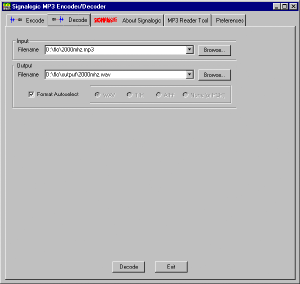
SigC54xx-PC/104 Board "MP3 Production System"
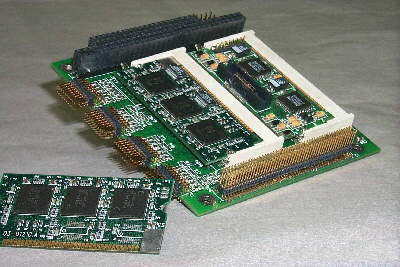
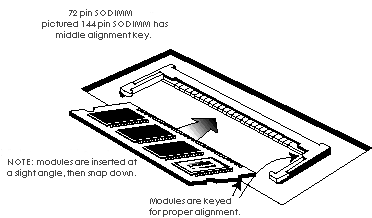
Software Support and Debug



